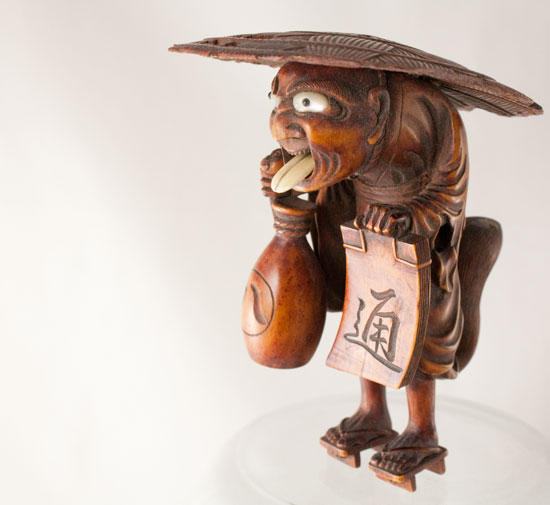What Spirit Gives Things Their Life?
Sat, 1.10.2015. Is there a lifeforce that inhabits THINGS? I don't mean the voice of consumer crap that calls out to us, "Buy me!" I mean the subtle spirit of old things and hand-made things -- that magical quality of an artifact that tells a story, that moves it along trade routes, that propels it through history, that makes people want to care for it. A subtle but powerful energy that makes some things endure while the others find themselves disintegrating at the bottom of the trash heap.
We all know that some objects carry memories and sentimentality -- family, travel, and romantic treasures. Mementos and souvenirs. But what about objects with no obvious personal connection -- flea market finds, vintage jewelry, old linens that "must be good for something"? They have energy, a spirit that speaks to us. Collectors and hoarders know this.
Anyway, what can we call this "spirit in things"? What is its name? I went searching. I found a few helpful concepts.
Universal animating lifeforce
 Qi (氣) [pronounced chee]. This is the Chinese term for a universal lifeforce that flows through everything. It not only vitalizes people and animals, but everything in the cosmos. It literally means breath... like your breath on a cold day, or steam rising from a pot. Wind is the cosmic qi. Qi permeates and links everything. Feng shui, the art of furniture arranging, taps into qi. Manfred Porkert said, "When Chinese thinkers are unwilling or unable to fix the quality of an energetic phenomenon, the character qi inevitably flows from their brushes."
Qi (氣) [pronounced chee]. This is the Chinese term for a universal lifeforce that flows through everything. It not only vitalizes people and animals, but everything in the cosmos. It literally means breath... like your breath on a cold day, or steam rising from a pot. Wind is the cosmic qi. Qi permeates and links everything. Feng shui, the art of furniture arranging, taps into qi. Manfred Porkert said, "When Chinese thinkers are unwilling or unable to fix the quality of an energetic phenomenon, the character qi inevitably flows from their brushes."
Pneuma (Greek) The Stoic tradition of ancient Greece (circa 3rd c. BCE) identified pneuma as the breath of life, as a mixture of air (in motion) and fire (as warmth). For them it is the active, generative principle that organizes both the individual and the cosmos. In its highest form it is the human soul (psyche). As a force that structures matter, it exists even in inanimate objects. If logos is divine reason, active and organizing, then pneuma is the vehicle of logos in structuring the physical world. The cosmos is a whole and single entity, a living thing with a soul of its own, held together by the divine pneuma that pervades it.
Ruah or Ruach (Hebrew). The breath of God that animates all things. It connotes the creative, generative work of God. I don't know if is comparable to qi in imparting a lifeforce to all things. But I keep coming back to this beautiful word, maybe because it reminds me of high school religion class.
Mana (Polynesian). A spiritual quality considered to have supernatural origin—a sacred non-personal force existing in the universe. Therefore to have mana is to have influence and authority, and efficacy—the power to perform in a given situation. This essential quality of mana is not limited to persons—peoples, governments, places and inanimate objects can possess mana. Polynesian art objects are traditionally home to their gods (atua) and are imbued with the power of mana. We saw the National Gallery of Australia traveling exhibit on this topic when we were in St. Louis. My impression was that the shaman/artist who carves the object is the one who draws the mana into it, invoking its power to heal, protect, etc.
Other gifts of Life
The Japanese Shinto religion finds kami throughout all of nature. Spirits inhabit everything but I think it's an outdoorsy thing, akin to pagan or para-Christian belief in fairies and wood nymphs. I haven't seen it applied to objects. On the other hand, Japanese folklore tells the story of tsukumogami, "kami of tool" -- if a household object endures 100 years, it receives a soul, which can cause mischief if not treated with respect. This reminds me of the story of The Velveteen Rabbit, where toys come to life if they are loved long enough.
Pinocchio comes to life too, doesn't he? Then of course there is the demon-possessed Chucky who entered the world in the movie Child's Play (1988). Things with life do have the power to terrify us
Ever since I opened my eBay store in 2005, I've nurtured a theory that old things accumulate a certain "life energy" from being handled and appreciated by their owners. If nothing else, there must be a great deal of transfer of surface electrons between object and owner. Many owners over a long period of time create a wonderful aura of liveliness that those who love it can sense -- why "the real thing" is better than a photo or a reproduction. You can't tell me that a battered baseball card doesn't contain the spirit of a little boy.
Spirit of the Artist
One school of thought argues that it is the artist-maker of a thing who brings it to life. Alfred Gell ("Technology of Enchantment..." in Anthropology, Art, and Aesthetics, 1992) talks about the "alchemy of art." Artists and artisans make "what is" out of "what is not." Their work seems miraculous because it combines human skill at such a high level that people claim to sense the divinity behind it. What enlivens an object, what gives it power is the artist herself, who is assumed to have experienced [in my words] the inspiring breath of God (see ruah above).
Henry Glassie (Spirit of Folk Art) defines art as a communication. It is interplay between creator and a small group. The artist and the collective become unified. The spirit in a piece of art may be like a message in a bottle to the audience -- it conveys the maker's pleasure and playfulness in making the object. The artist can convey a wide range of feelings, including power, terror, and pity. But they convey not only feelings. They also tell a story, engaging our minds. The maker is communicating her own passionate union with her materials; there is meaning and symbolism underlying the work. The women in Bangladesh, who make kantha quilts from old clothes, recapitulate the construction of the universe and, in the process, stitch their families together.
Henry Glassie proclaims: "Art moves the senses to open the mind, for both its makers and perceivers."
I don't know... this seems to be taking me a long way from Chucky and qi. Do old and hand-made things have their own spirits? Or are they vehicles through which artists and gods tell us their story?
The search continues...
***

